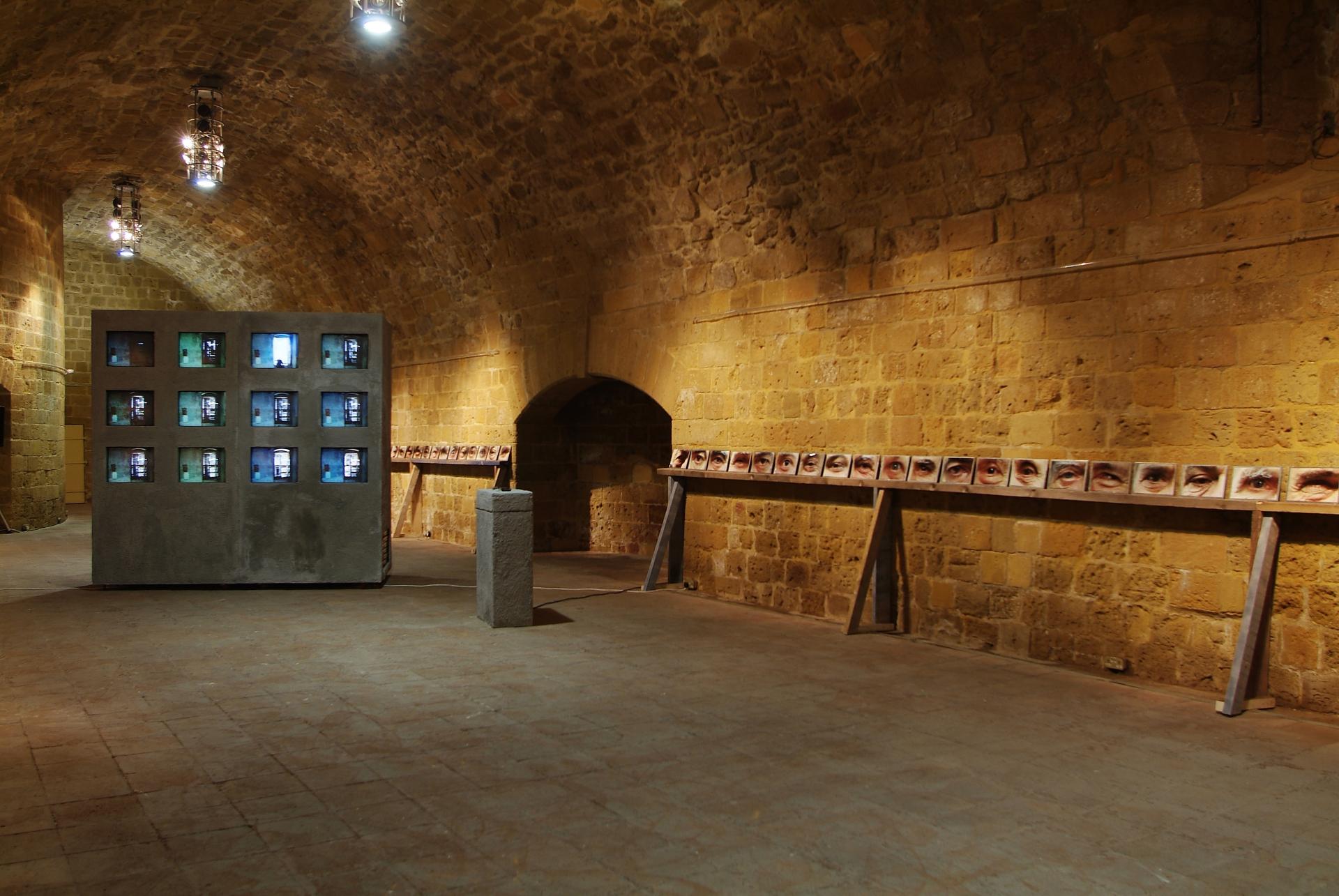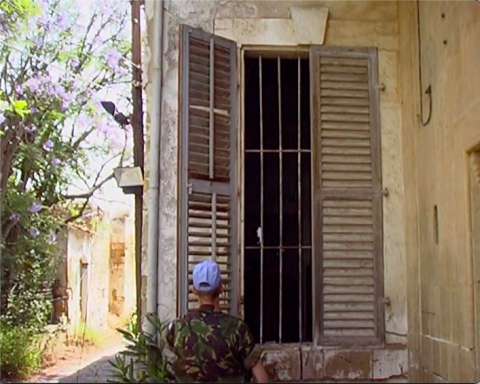Two quotations from texts about the video installation that deal with the symbolism of the work:
"The triad eye, window, soul is intimately connected. What I see determines my horizon. The limits of my perception are the limits of my consciousness. The images I see shape and educate, form and determine me in one way or another, for good or ill. If, as is so often claimed, they already have more effect as a single word than a thousand words, our responsibility for the optics of the world and its images grows proportionately.
...
Sylvia Henze's work "Window" takes its starting point from a very concrete political situation in Europe, the problems of which she presents without, however, stopping there. This going further, this transcending of the political situation and its problems through a consciously chosen formal language and through the evocation of additional levels of meaning, makes the work an artistic one. The semantic struggles that surround Henze's work include not only insights into the nature and linkage of truth and perception, but also the opening of a space for reflection that touches the viewer personally because it deals with the theme of fear, insecurity and threat.
...
Certainly, the theme has a lot to do with the changes in the social and societal security systems that many of us are painfully experiencing: so painfully that the sociologist Ulrich Beck is already talking about a "Brazilianisation of the West". Fear has always been an instrument of securing power, whether in the wars of the economy or the military. We can only counter it if we recognise its causes. Only then will we no longer be afraid of fear. Works like those by Sylvia Henze help us to do this."
Michael Stoeber, author
"The Window is an opening in the wall, for the admission of Light and Air. Its from the Old Norse vindauga, which combines vindr (the wind) and auga (the eye), therefore, literary: 'to see the wind', a metaphor for the Receptive state of mind towards the Truth. Like in the Eye and the Lens, so on the mental plane: it is the aperture and the crack that lets the light in and regulates Awareness, the receptivity of the Image and the clarity of its Perception. Open, the light streams in and allows for depth of field and sharpness of vision, and there is Hope. Starved of Light, perception is dimmed, blurred, and once made sterile, it stagnates and is swallowed back into the darkness, to die.
Sylvia Henze's "Window", is an extraordinary window. It doesn't open or shut to the rhythm and needs of the seasons nor of its owners, nor has it ever been maintained since 1974. A life in transit, in blurred darkness, a life of waiting, as the cracks on the walls grow wider, as the world outside grows indifferent and the wild thistles grows taller.
Sylvia Henze's "Window" does not only record the aftermath and imposed absurdity of 'failed diplomacy', but also its very root. It is also a recording of the mental boundaries that conceived and projected the dividing line onto the physical plane. This 'crippled life' of our Window, this dysfunction, is also the mental state that lead us to the dark cul-de-sacs and blind alleys of unresolved conflicts, out of which we, and the generations that follow, will be called to exit from. Despite the opening of the gates across and the still timid movement of peoples keen to revisit ancestral roots on the 'other side', our windows remain stubbornly shut and we continue to gaze across the boundaries of our limited awareness... "
Kyras Tsimon, author, himself displaced in Cyprus.
"The triad eye, window, soul is intimately connected. What I see determines my horizon. The limits of my perception are the limits of my consciousness. The images I see shape and educate, form and determine me in one way or another, for good or ill. If, as is so often claimed, they already have more effect as a single word than a thousand words, our responsibility for the optics of the world and its images grows proportionately.
...
Sylvia Henze's work "Window" takes its starting point from a very concrete political situation in Europe, the problems of which she presents without, however, stopping there. This going further, this transcending of the political situation and its problems through a consciously chosen formal language and through the evocation of additional levels of meaning, makes the work an artistic one. The semantic struggles that surround Henze's work include not only insights into the nature and linkage of truth and perception, but also the opening of a space for reflection that touches the viewer personally because it deals with the theme of fear, insecurity and threat.
...
Certainly, the theme has a lot to do with the changes in the social and societal security systems that many of us are painfully experiencing: so painfully that the sociologist Ulrich Beck is already talking about a "Brazilianisation of the West". Fear has always been an instrument of securing power, whether in the wars of the economy or the military. We can only counter it if we recognise its causes. Only then will we no longer be afraid of fear. Works like those by Sylvia Henze help us to do this."
Michael Stoeber, author
"The Window is an opening in the wall, for the admission of Light and Air. Its from the Old Norse vindauga, which combines vindr (the wind) and auga (the eye), therefore, literary: 'to see the wind', a metaphor for the Receptive state of mind towards the Truth. Like in the Eye and the Lens, so on the mental plane: it is the aperture and the crack that lets the light in and regulates Awareness, the receptivity of the Image and the clarity of its Perception. Open, the light streams in and allows for depth of field and sharpness of vision, and there is Hope. Starved of Light, perception is dimmed, blurred, and once made sterile, it stagnates and is swallowed back into the darkness, to die.
Sylvia Henze's "Window", is an extraordinary window. It doesn't open or shut to the rhythm and needs of the seasons nor of its owners, nor has it ever been maintained since 1974. A life in transit, in blurred darkness, a life of waiting, as the cracks on the walls grow wider, as the world outside grows indifferent and the wild thistles grows taller.
Sylvia Henze's "Window" does not only record the aftermath and imposed absurdity of 'failed diplomacy', but also its very root. It is also a recording of the mental boundaries that conceived and projected the dividing line onto the physical plane. This 'crippled life' of our Window, this dysfunction, is also the mental state that lead us to the dark cul-de-sacs and blind alleys of unresolved conflicts, out of which we, and the generations that follow, will be called to exit from. Despite the opening of the gates across and the still timid movement of peoples keen to revisit ancestral roots on the 'other side', our windows remain stubbornly shut and we continue to gaze across the boundaries of our limited awareness... "
Kyras Tsimon, author, himself displaced in Cyprus.





